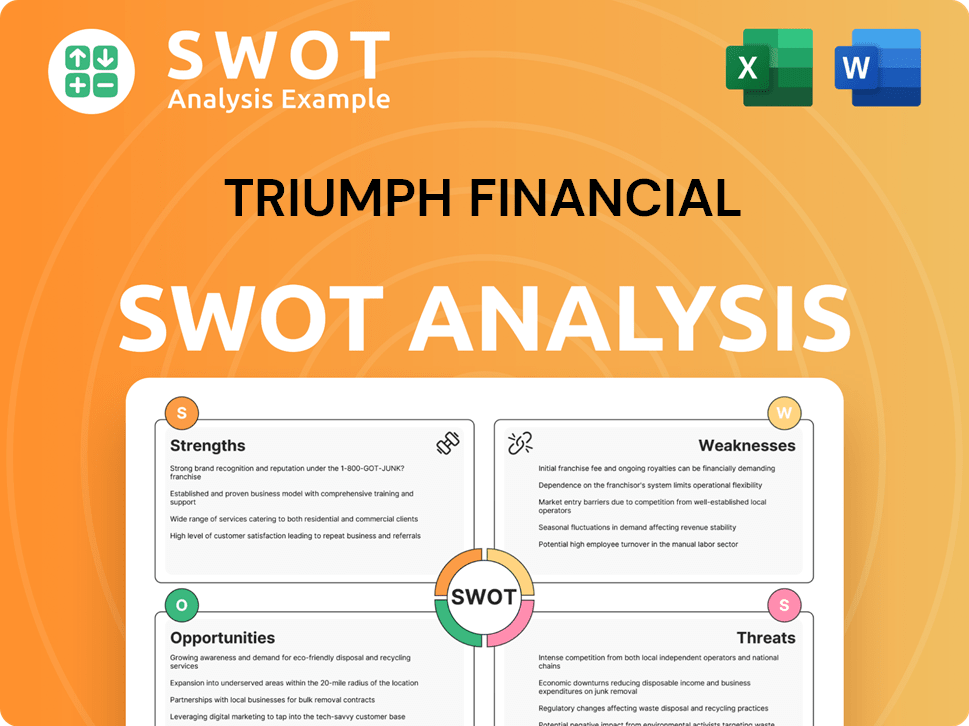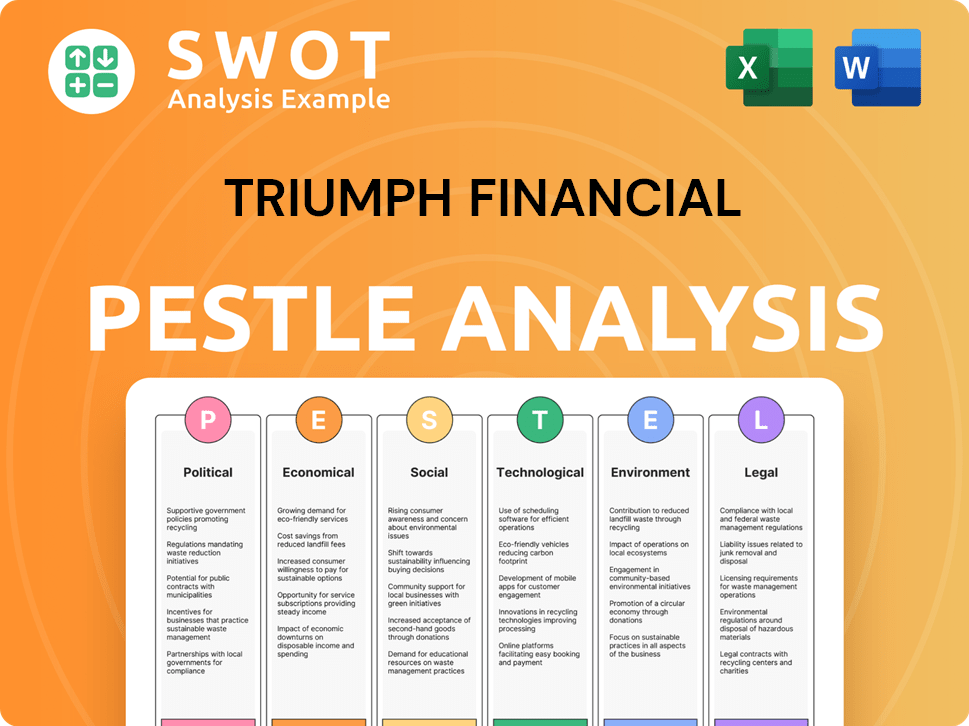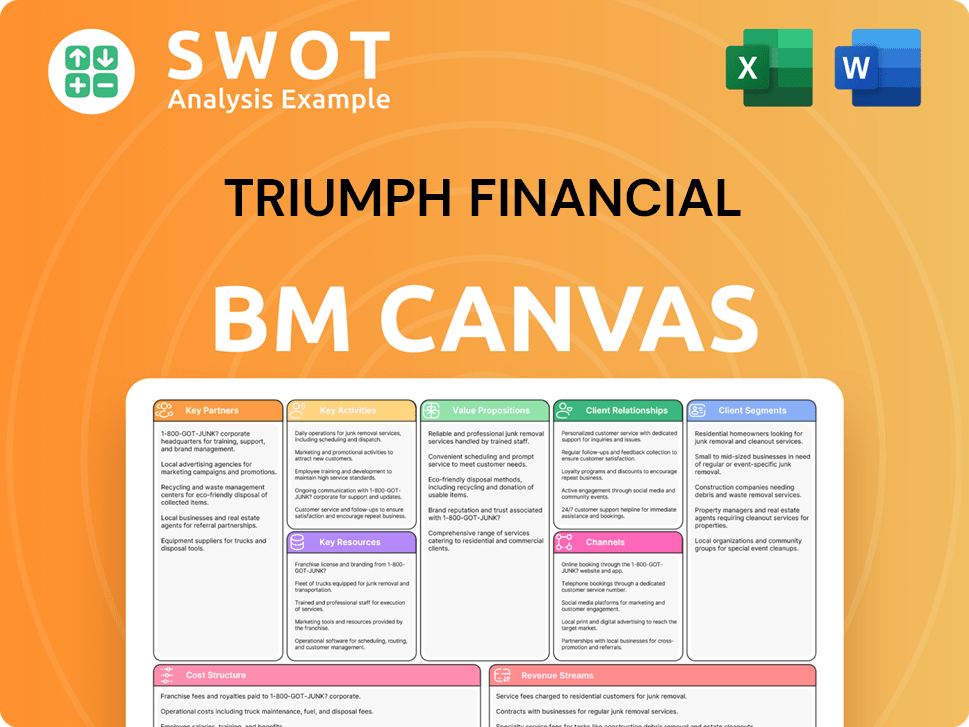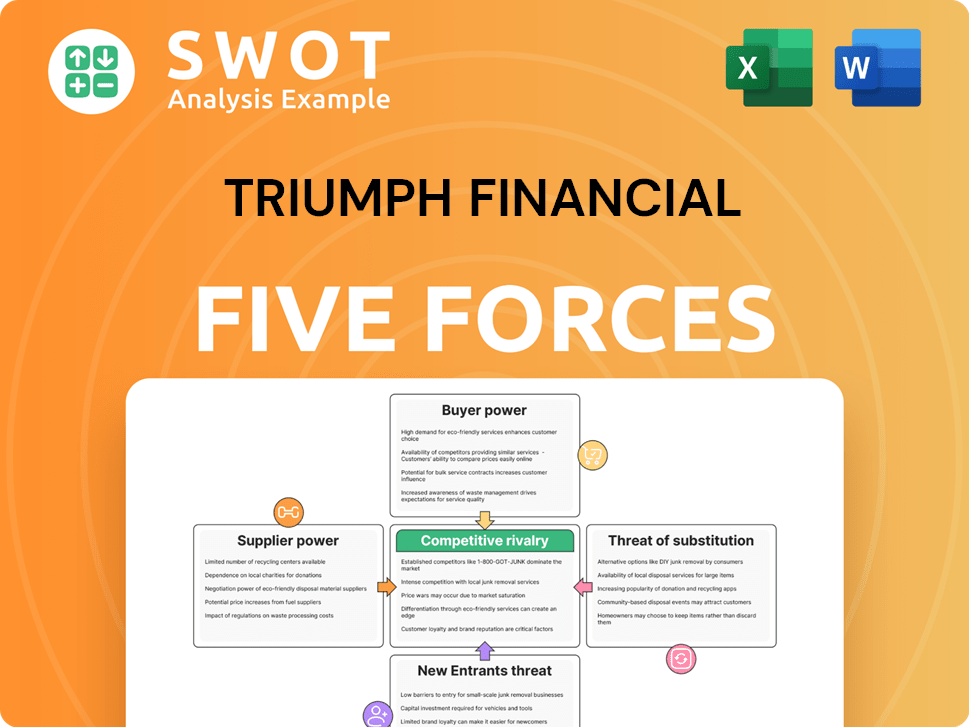Triumph Financial Bundle
Who Does Triumph Financial Serve?
In the competitive world of Triumph Financial SWOT Analysis, understanding the customer is key. This article dives deep into the customer demographics and target market of Triumph Financial, a company built on serving the transportation industry. We'll explore how Triumph's customer profile has evolved, and how it adapts to meet their needs.

Gaining a clear picture of Triumph Financial's target market is crucial for investors, analysts, and anyone interested in the financial services sector. This detailed market analysis will uncover the specific customer demographics, including industries served, geographic focus, and financial needs. By examining these factors, we can better understand Triumph's growth strategies and its ability to navigate the ever-changing financial landscape, ultimately providing valuable insights into its future prospects.
Who Are Triumph Financial’s Main Customers?
Understanding the customer demographics and target market is crucial for assessing the business strategy of any financial institution. For Triumph Financial, this involves a deep dive into its primary customer segments. The company's focus is primarily business-to-business (B2B), with a strong emphasis on the transportation industry.
The core of Triumph Financial's customer base includes small to medium-sized trucking companies, independent owner-operators, and freight brokers. These entities share a common need for specialized financial services. These services address the unique challenges of the transportation sector, such as managing cash flow fluctuations, acquiring and maintaining equipment, and mitigating risks associated with freight movement.
While specific demographic breakdowns like age, gender, or education level for individual business owners are not publicly detailed, the focus is on the operational characteristics and financial needs of their businesses. This customer profile allows for a targeted approach to service delivery and product development.
Triumph Financial's services cater to a wide range of operational scales within the transportation industry. This includes single-truck owner-operators and larger fleets. The company's payment processing solutions serve both carriers and brokers.
The company initially focused on factoring services. It has expanded into payment processing and insurance solutions. This has broadened its appeal and captured a larger share of the transportation financial services market.
TriumphPay processed a substantial $33.2 billion in payments in 2023. This reflects a significant increase from previous years. This highlights its strong penetration within the freight payment ecosystem. The growth in payment processing has been a key driver for Triumph Financial.
- Factoring services provide immediate cash flow solutions for smaller operators.
- Equipment financing supports the expansion of larger fleets.
- Payment processing streamlines transactions between carriers and brokers.
- Insurance solutions help mitigate risks within the transportation sector.
Triumph Financial SWOT Analysis
- Complete SWOT Breakdown
- Fully Customizable
- Editable in Excel & Word
- Professional Formatting
- Investor-Ready Format

What Do Triumph Financial’s Customers Want?
Understanding the customer needs and preferences is crucial for any financial institution, and for Triumph Financial, this means focusing on the transportation industry. The company's success hinges on its ability to meet the specific financial demands of trucking companies and owner-operators. A deep dive into these needs reveals key drivers that shape customer choices and influence the services offered.
Triumph Financial's target market prioritizes solutions that address cash flow challenges, access to capital, and risk mitigation. This focus allows Triumph to tailor its products and services to meet the unique requirements of its customer base. By understanding these needs, Triumph Financial can refine its offerings and maintain a strong market position.
The primary goal of Triumph Financial is to provide financial services to the transportation industry. The company's customer base includes trucking companies and owner-operators. These customers often face challenges related to cash flow, access to capital, and risk management. Triumph Financial offers factoring services, equipment financing, and insurance solutions to address these needs.
Factoring services are a cornerstone, providing immediate cash for invoices. This helps trucking companies manage day-to-day expenses. The speed of funding is a key factor in customer decisions.
Equipment financing is essential for fleet expansion and upgrades. Customers prefer flexible terms and quick approval processes. The transportation industry requires significant capital investment.
Insurance solutions protect against unforeseen events. This is especially important in the high-risk transportation sector. These services provide peace of mind for customers.
TriumphPay streamlines freight payments, addressing a common industry pain point. The platform enhances user experience and streamlines transactions. Technology plays a crucial role in customer satisfaction.
Customer feedback influences the development of digital offerings. Faster payments and integrated solutions are key demands. Triumph Financial adapts to meet evolving customer needs.
Triumph aims to provide a complete financial ecosystem for the transportation industry. This includes factoring, financing, and insurance. The goal is to be a one-stop financial solution.
The decision-making process for customers often centers on speed, rates, accessibility, and reliability. Triumph's focus on these factors helps it attract and retain clients. For more details on the company's growth strategy, you can read about it in Growth Strategy of Triumph Financial.
The primary needs of Triumph Financial's customers are efficient cash flow, access to capital, and risk mitigation. These needs drive the demand for factoring services, equipment financing, and insurance solutions. Customer preferences include speed of funding, competitive rates, ease of access, and platform reliability.
- Factoring Services: Provide immediate cash flow by purchasing invoices.
- Equipment Financing: Support fleet expansion and upgrades with flexible terms.
- Insurance Solutions: Offer protection against unforeseen events in the transportation sector.
- Technology Platforms: Streamline transactions and improve user experience.
- Customer Feedback: Drive the development of new digital offerings and integrated solutions.
Triumph Financial PESTLE Analysis
- Covers All 6 PESTLE Categories
- No Research Needed – Save Hours of Work
- Built by Experts, Trusted by Consultants
- Instant Download, Ready to Use
- 100% Editable, Fully Customizable

Where does Triumph Financial operate?
The geographical market presence of the company is primarily within the United States. It offers its financial services across all 50 states. This broad reach is a key aspect of its operational strategy, enabling it to serve a diverse customer base across the country.
Given its specialization in the transportation sector, the company's strongest market presence aligns with major trucking routes and logistics hubs. These areas typically have a high concentration of trucking companies and significant freight activity, which are core to its target market. While specific market share data by city or region isn't publicly available, its extensive digital platforms and nationwide sales force ensure comprehensive coverage.
The company's customer base is not significantly differentiated across U.S. regions. The fundamental needs of transportation businesses, such as cash flow management and equipment financing, remain consistent nationwide. However, the density of clients may vary depending on the concentration of transportation businesses in specific areas. The company focuses on providing a consistent suite of financial solutions to meet the universal needs of the transportation industry, rather than localizing offerings by state.
The company's geographic focus is primarily within the United States, serving all 50 states. This widespread presence is crucial for supporting the transportation industry across the country.
Its strongest market presence is in areas with high trucking activity and logistics hubs. These regions are vital for its customer base within the transportation sector. This strategic focus helps maximize service efficiency.
Customer needs are consistent across regions, with a focus on cash flow, equipment financing, and risk management. This consistency allows the company to offer standardized financial solutions.
The company focuses on expanding service offerings and digital capabilities within its existing market. This approach aims to deepen its market penetration rather than significant international expansion. Read more about the Growth Strategy of Triumph Financial.
Triumph Financial Business Model Canvas
- Complete 9-Block Business Model Canvas
- Effortlessly Communicate Your Business Strategy
- Investor-Ready BMC Format
- 100% Editable and Customizable
- Clear and Structured Layout

How Does Triumph Financial Win & Keep Customers?
Understanding the customer demographics and effectively reaching the target market are crucial for the success of any financial institution. This is especially true for a company like Triumph Financial, which specializes in providing financial services to the transportation industry. Their strategies encompass both attracting new clients and retaining existing ones.
Triumph Financial employs a multi-faceted approach to acquire and retain customers. This includes a combination of direct sales, digital marketing, and relationship building. The company's focus on the transportation sector allows for specialized service offerings and targeted communication, which helps them to stand out in a competitive market. This sector-specific approach is a key element of their customer acquisition and retention strategies.
Customer acquisition and retention strategies at Triumph Financial are designed to meet the unique needs of the transportation industry. They leverage direct sales teams, digital marketing, and industry events to attract new clients. Simultaneously, they focus on providing excellent customer service, technological advancements, and integrated financial services to keep customers satisfied and loyal.
Direct sales teams are a cornerstone of Triumph Financial's acquisition strategy. These teams build relationships with trucking companies, owner-operators, and freight brokers. This approach allows for personalized service and a deep understanding of their clients' needs. They can offer tailored financial solutions that address specific industry challenges.
Digital marketing plays a crucial role in reaching the target market. Online advertising, content marketing, and SEO are used to attract potential clients. This includes creating industry-specific content such as articles and guides. This approach helps to increase visibility and attract clients seeking financial solutions.
Referrals from satisfied customers and partnerships with industry players are valuable sources of new business. This is a testament to the company's commitment to customer satisfaction and its strong industry presence. Building trust and credibility through these channels is a key aspect of their growth strategy.
Participation in industry trade shows and events enhances visibility and provides opportunities for direct engagement. This allows Triumph Financial to connect with potential clients and demonstrate its commitment to the transportation sector. These events are a key part of their marketing and sales efforts.
For retention, Triumph Financial prioritizes customer service and personalized experiences. They utilize dedicated account managers, technology platforms like TriumphPay, and an integrated service approach to foster customer loyalty. This holistic approach ensures that clients receive comprehensive financial solutions tailored to their needs, increasing customer lifetime value.
Dedicated account managers understand the unique financial challenges of the transportation sector. They provide personalized support and build strong relationships with clients. This personalized approach ensures that clients receive tailored solutions and exceptional service.
The development and continuous improvement of technology platforms, such as TriumphPay, are central to retention. These platforms offer efficient and transparent payment processing. This enhances customer experience and builds loyalty within the transportation industry.
The value proposition of integrated financial services, making Triumph a one-stop shop, contributes to customer stickiness. By providing factoring, lending, payments, and insurance solutions, they meet various client needs. This approach simplifies financial management for their clients.
Customer data and CRM systems are used to track interactions and understand customer needs. This allows Triumph Financial to tailor communications and service offerings. This data-driven approach enhances customer relationships and satisfaction.
Changes in strategy have included a greater emphasis on digital transformation and service integration. This creates a more seamless customer experience. This has positively impacted customer lifetime value by increasing engagement and reducing churn, driving growth for the company.
By focusing on customer lifetime value, Triumph Financial aims to maximize the long-term profitability of its customer relationships. This involves strategies that enhance customer engagement and reduce churn. This approach is crucial for sustainable growth.
A thorough market analysis helps Triumph Financial understand its competitive landscape. This involves identifying key competitors and assessing their strengths and weaknesses. The company's focus on the transportation sector provides a competitive advantage.
- Customer Profile: Trucking companies, owner-operators, and freight brokers.
- Financial Services: Factoring, lending, payment solutions, and insurance.
- Geographic Focus: Primarily the United States, with a growing presence.
- Competitive Advantage: Specialized expertise in the transportation industry.
For more detailed insights into the financial performance and strategies of Triumph Financial, you can refer to Owners & Shareholders of Triumph Financial.
Triumph Financial Porter's Five Forces Analysis
- Covers All 5 Competitive Forces in Detail
- Structured for Consultants, Students, and Founders
- 100% Editable in Microsoft Word & Excel
- Instant Digital Download – Use Immediately
- Compatible with Mac & PC – Fully Unlocked

Related Blogs
- What are Mission Vision & Core Values of Triumph Financial Company?
- What is Competitive Landscape of Triumph Financial Company?
- What is Growth Strategy and Future Prospects of Triumph Financial Company?
- How Does Triumph Financial Company Work?
- What is Sales and Marketing Strategy of Triumph Financial Company?
- What is Brief History of Triumph Financial Company?
- Who Owns Triumph Financial Company?
Disclaimer
All information, articles, and product details provided on this website are for general informational and educational purposes only. We do not claim any ownership over, nor do we intend to infringe upon, any trademarks, copyrights, logos, brand names, or other intellectual property mentioned or depicted on this site. Such intellectual property remains the property of its respective owners, and any references here are made solely for identification or informational purposes, without implying any affiliation, endorsement, or partnership.
We make no representations or warranties, express or implied, regarding the accuracy, completeness, or suitability of any content or products presented. Nothing on this website should be construed as legal, tax, investment, financial, medical, or other professional advice. In addition, no part of this site—including articles or product references—constitutes a solicitation, recommendation, endorsement, advertisement, or offer to buy or sell any securities, franchises, or other financial instruments, particularly in jurisdictions where such activity would be unlawful.
All content is of a general nature and may not address the specific circumstances of any individual or entity. It is not a substitute for professional advice or services. Any actions you take based on the information provided here are strictly at your own risk. You accept full responsibility for any decisions or outcomes arising from your use of this website and agree to release us from any liability in connection with your use of, or reliance upon, the content or products found herein.